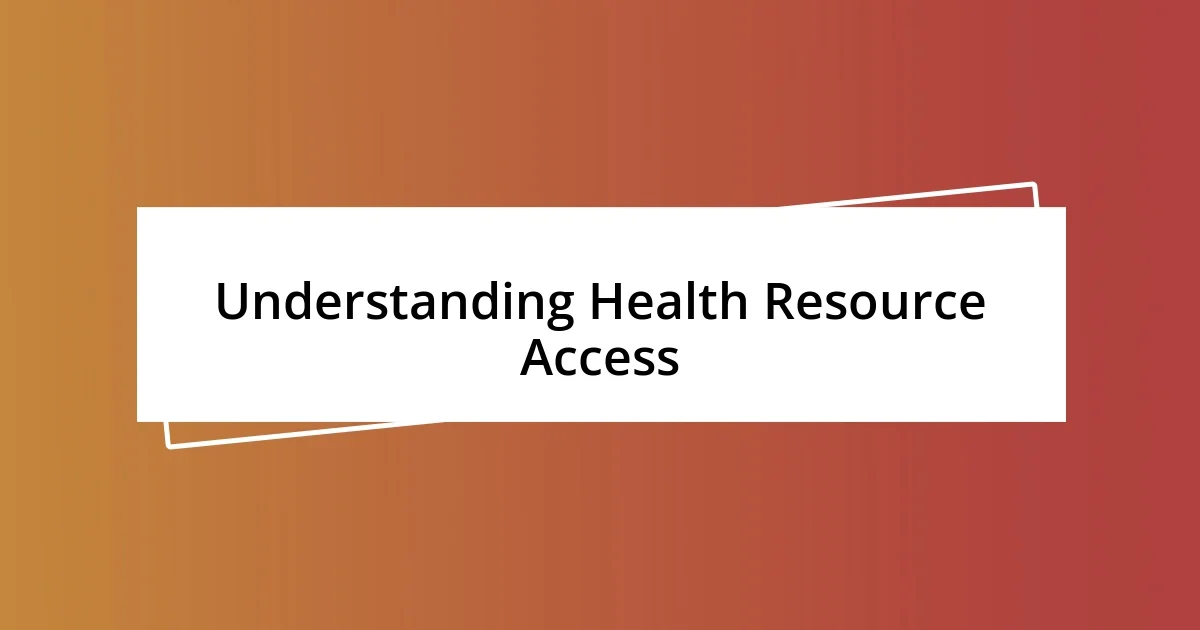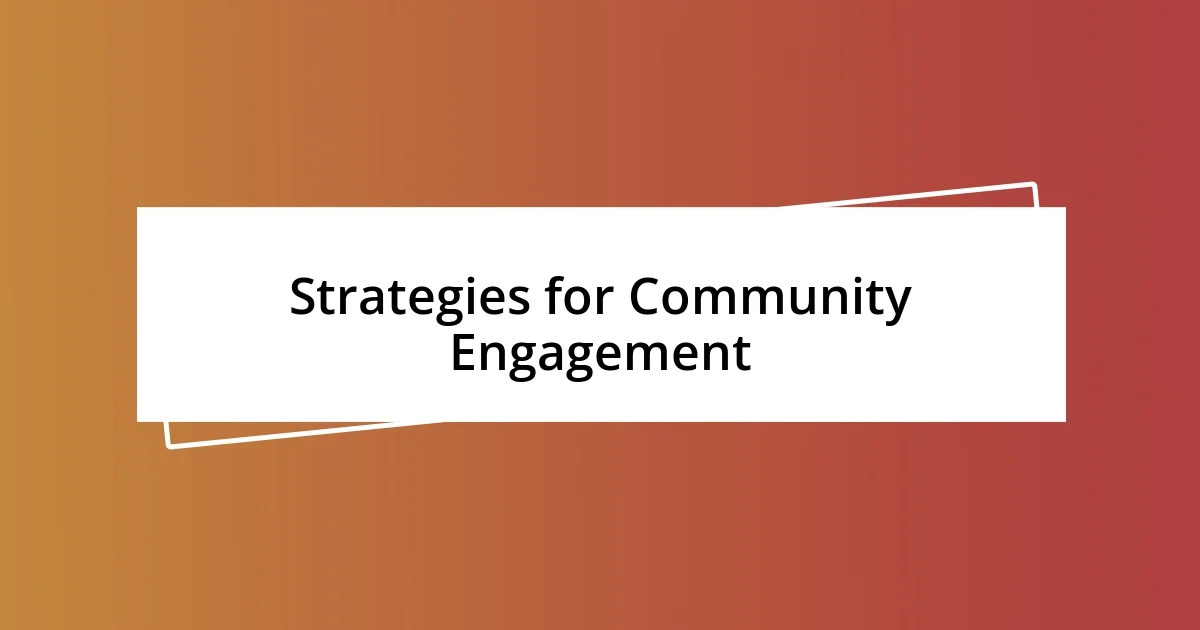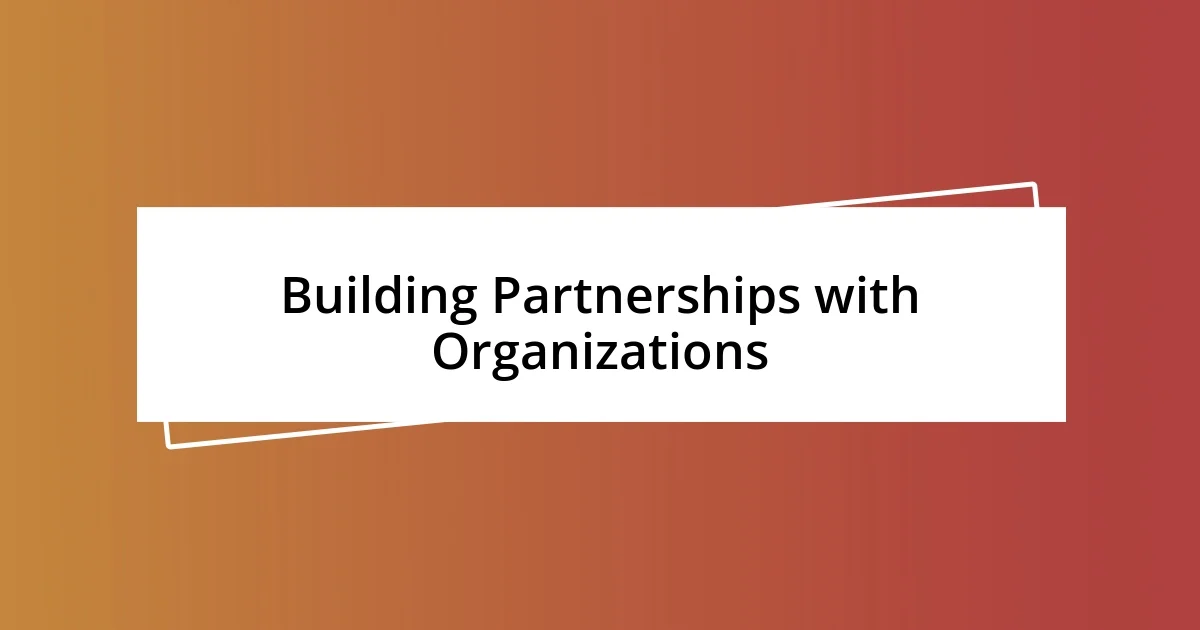Key takeaways:
- Barriers to health resource access include financial constraints, transportation issues, cultural stigmas, and limited service availability, which require community-driven solutions to overcome.
- Engaging the community through grassroots involvement, informative workshops, and partnerships with local organizations fosters trust, increases participation, and enhances resource accessibility.
- Ongoing evaluation and adaptability of health programs, driven by community feedback, are essential for sustainability and for ensuring that initiatives effectively meet the needs of participants.

Understanding Health Resource Access
Understanding health resource access is essential because it directly impacts individual well-being. When I think back to a time when a close friend faced a medical crisis, I was struck by how fear can cloud judgment. They were unsure of where to seek help, highlighting just how crucial it is to know what resources are available and how to navigate them effectively.
Access isn’t just about having services available; it’s about the ability to utilize them without barriers. I remember my own experience trying to book a simple check-up appointment during a bustling flu season. The clinics were overloaded, and I felt lost in the chaos. It really made me question—what good are health resources if we can’t actually reach them when we need them most?
Furthermore, financial implications often complicate access. During my volunteering days at a local health fair, I saw many families hesitant to seek preventive care simply because they feared the costs. This raised a poignant thought for me: Shouldn’t everyone have equal opportunity to seek health resources without the burden of financial stress hanging over their heads? It’s moments like these that underscore the need for equitable access for all individuals, regardless of their background.

Identifying Barriers to Access
Identifying the barriers individuals face in accessing health resources is a critical step in understanding the broader picture of health equity. I remember volunteering at a community center where we conducted surveys to gather information on local residents’ healthcare experiences. The responses were eye-opening—people reported a range of obstacles, from long travel distances to cultural stigma surrounding seeking help. It really hit home for me that access isn’t just a logistical issue; it often intertwines with personal beliefs and fears.
Here are some common barriers that can hinder access to health resources:
- Financial Constraints: Many individuals either lack insurance or worry about the costs associated with care.
- Transportation Issues: Limited public transport or long travel distances can deter people from seeking necessary services.
- Cultural and Language Barriers: Fear of judgment or inability to communicate can keep potential patients from reaching out for assistance.
- Limited Availability of Services: In underserved areas, simply put, there may not be enough clinics or specialists to meet demand.
- Health Literacy: A lack of understanding about how to navigate the healthcare system can leave individuals feeling lost.
Each of these barriers sheds light on the complexities of health resource access. When I think about what I’ve seen and heard, it’s clear that overcoming these obstacles requires not just awareness but a thoughtful, community-driven approach.

Strategies for Community Engagement
Engaging the community to improve access to health resources is vital to effecting change. I’ve learned from experience that grassroots involvement generates genuine impact. For instance, during a community health initiative, I collaborated with local leaders who understood cultural nuances and could convey tailored messages. This approach fostered trust and increased participation, making it clear to me that local voices can resonate more effectively than top-down directives.
Another strategy I found valuable was hosting informative workshops. These gatherings create safe spaces for dialogue, allowing community members to express their concerns and seek clarification. I recall a workshop focused on mental health; it not only educated participants but also empowered them to share personal stories, breaking the stigma that often surrounds these topics. By creating a supportive environment, we significantly enhanced awareness and engagement, demonstrating the power of community.
Finally, partnering with local businesses and organizations can create powerful synergies. When I teamed up with a nearby health food store to provide free nutrition workshops, we saw stunning turnout. It reminded me that when resources are effectively aligned, communities can thrive. These collective efforts remind me of an important truth: we all have a role to play in championing access to health resources.
| Strategy | Details |
|---|---|
| Grassroots Involvement | Collaborate with local leaders to build trust in the community. |
| Workshops | Host events that promote dialogue and educate participants. |
| Partnerships | Team up with local organizations to leverage resources and outreach. |

Building Partnerships with Organizations
Building partnerships with organizations has been a game changer in my efforts to enhance access to health resources. I remember the first time I approached a local non-profit about collaborating on a health fair. Initially, I felt nervous—would they understand my vision? To my surprise, they were eager to get involved, and together we brought in diverse health professionals who catered to various needs within our community. This experience taught me that shared goals can create powerful momentum.
As I continued to build these partnerships, I learned the importance of aligning missions. Partnering with an educational institution allowed us to conduct research on community health needs. This data drove informed decisions that truly resonated with our audience. It made me realize that collaboration isn’t just about sharing resources; it’s about co-creating solutions with a deep understanding of each other’s strengths and limitations. Have you ever partnered with others for a cause? The right alliances can amplify your impact in the most unexpected ways.
Moreover, I found that partnerships also fostered a sense of accountability. When I worked alongside a health advocacy group, we regularly checked in on each other’s progress. This mutual commitment not only kept us motivated, but it also transformed our initial plans into actionable outcomes. It’s fascinating how having someone in your corner can uplift your mission, isn’t it? Looking back, these collaborations taught me that progress often happens at the intersection of different perspectives, experiences, and expertise.

Creating Sustainable Health Programs
Creating sustainable health programs requires intentional planning and flexibility. I recall a project where we aimed to set up a series of fitness classes for seniors. We didn’t just select instructors; instead, I organized a community forum to invite seniors to share their interests and preferences. This simple act of listening not only shaped our curriculum but also built a sense of ownership among participants. Isn’t it amazing how involving the community upfront can lead to programs that resonate more deeply with their needs?
In another instance, I encountered challenges when implementing health screenings in an underserved neighborhood. Initially, attendance was low, and it was disheartening. Realizing that we hadn’t fully addressed transportation barriers, I partnered with a local transportation service to provide free rides. This change transformed our program—a true example of how adaptability is crucial for sustainability. I often wonder, how many health initiatives falter because we overlook such simple yet impactful solutions?
Furthermore, the concept of ongoing evaluation cannot be overstated. I’ve learned that checking in after program implementation is essential. For instance, after launching a mental health awareness campaign, we sought feedback through follow-up surveys and focus groups. The insights we gathered allowed us to tweak our approach, ensuring that our efforts weren’t just a one-time event but a lasting resource for the community. How often do we consider that feedback loop? It’s a pivotal step that often brings benefits we can’t foresee initially.

Evaluating Impact of Initiatives
Evaluating the impact of health initiatives is like holding up a mirror to our efforts, and I can’t emphasize enough how important that reflection can be. I remember a moment after a health literacy workshop we conducted, where participants expressed not just gratitude but also a noticeable shift in their confidence about navigating healthcare systems. It was eye-opening to see that our work was resonating so profoundly. How do we truly measure that kind of shift? It reminds me that qualitative feedback, such as personal stories, can be just as critical as hard data in showing impact.
In my experience, metrics and analytics are invaluable for understanding the effectiveness of programs. I once analyzed pre- and post-surveys from a nutrition education program, revealing a 40% increase in participants’ knowledge about healthy eating. However, the numbers don’t tell the entire story. Some community members shared how they were now cooking healthier meals for their families, fostering a ripple effect that extended beyond our initial goals. Isn’t it fascinating how one initiative can inspire changes in multiple lives?
Another essential aspect of evaluating impact is adaptability based on feedback. When I conducted follow-up interviews after a dental health outreach, many expressed gratitude but pointed out a lack of follow-up care options. This feedback drove me to collaborate with local dentists to ensure ongoing access to services. Reflecting on those conversations was a pivotal moment; it taught me that evaluation isn’t just about measuring success; it’s about opening doors for continuous improvement. How often do we take a moment to listen for such insights? Those moments can illuminate paths we may not have previously considered.














